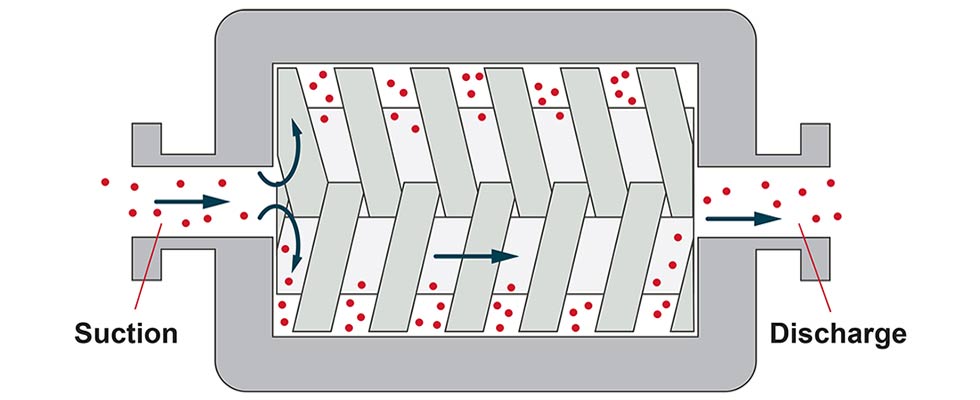
It is no secret that the food and beverage industry is ever-changing. According to the United States Department of Agriculture Economic Research Service, “New U.S. food and beverage product introductions in retail outlets, as tracked by Mintel’s Global New Product Database (Mintel GNPD), have followed an upward trend since the late 1990s, exceeding those of nonfood grocery items since 2010.
In 2016, food categories with the largest shares of overall new product introductions included beverages, snacks, bakery items, sauces, dressings and condiments.”
In the current food and beverage manufacturing landscape, choosing the right sanitary positive displacement (PD) pump is critical to supporting operational efficiency and product consistency while minimizing waste and downtime. There are a variety of PD pump technologies available to food processors today. Collectively, they can meet a wide range of performance capacities, pressures and viscosities. But not all PD pumps are created equal. And not every pump can tackle every application.
PD pumps move a product by repeatedly enclosing a fixed volume of the product and displacing it with each actuation, which can be broken down into two classifications: reciprocating and rotary. This article focuses primarily on rotary pumps, specifically: lobe pumps, circumferential piston pumps and twin screw pumps.
Common PD Pump Applications
- BAKERY: Dough, fats, fruit filling, icing, oil, yeast
- BEVERAGES: Beer, fruit concentrate, fruit juices, mash, wine
- CONFECTIONS: Chocolate, cocoa butter, corn syrup, gelatin, sugar
- CANNED FOODS: Tomatoes, baby food, jams, jellies, potato salad, pudding, relish, stews
- COSMETICS: Creams, emulsions, jellies, lotions, shampoo, toothpaste
- DAIRY: Butter, cream, curds, ice cream, margarine, milk, soft cheese, yogurt
- DRESSINGS: Mayonnaise, ketchup, sauces
- FLAVORINGS: Concentrates, syrups
- MEATS: Broth, fats, gelatin, pet foods, sausage fillings
The operating principle of these rotary PD pumps consists of two counter-rotating rotors located within the pump housing. As the rotors rotate within the pump housing, they move product through the pump by opening and closing volumes controlled by the spacing between the rotors.
On the suction side, an expanding cavity is formed between the rotor and pump housing. This creates a partial vacuum and allows product from the supply piping to fill the void. This volume then closes to both the inlet and outlet piping to transport a fixed volume of product to the opposite side of the pump where it is discharged when the rotors converge.
A Closer Look at Common Rotary PD Pumps
Rotary lobe and circumferential piston pumps are the two most-often used technologies for sanitary PD applications. Visually, they are similar, and depending on the manufacturer, these two pumps can even be made using common components, such as shafts and housings.
Both styles have two rotors that draw in product and transport it from suction to discharge. The tips or wings of the rotors create a near-contact sealing action within the pump housing. The space between the tips or wings denotes the volume of product being displaced.
What sets a rotary lobe pump apart from a circumferential piston pump is in the design of the rotors and the housing.
Lobe pump
Lobe pump rotors are in constant closeness with one another but never drive each other like a gear pump. The constant near-contact of the rotors creates a seal to transport product from the suction to the discharge side of the pump.
Overall, rotary lobe pumps are ideal for high viscous product and are the most affordable of the three types.
Circumferential piston pump
Circumferential piston pump rotors create the seal between stators that extend from the pump housing. The rotors also do not touch nor mesh. The sealing action only exists between the stators and rotors. Due to the additional geometric features, these pumps tend to be more expensive than lobe pumps. However, these features make circumferential piston pumps superior at low viscosity efficiency compared to lobe and twin screw pumps.
Twin screw pumps
Twin screw pumps are starting to become more common among PD pumps in food and beverage applications. The two-spindle design displaces product in an axial direction. This pump type has low pulsation, which reduces pump wear and aides in the gentle handling of product.
Low pulsation also helps the twin screw pump operate at higher revolutions per minute (rpm). This gives it the advantage of being able to also function as a (clean-in-place) CIP supply pump, thereby simplifying piping and controls.
Twin screw pumps are the most expensive option of these three PD pump types.


The PD Pump Advantage
If the application requires pumping a product that is high viscosity, shear sensitive or contains entrained solids, a PD pump is likely the best choice. While PD pumps have higher initial costs, the operating costs and product benefits like the ability to maintain soft solids, protect flavoring and product particulate can make it a sensible choice.
Other things to consider when choosing a PD pump for food and beverage applications include:
- compliance with 3-A Sanitary
- Standards Inc. (3-A SSI)
- European Hygienic Equipment Design Group (EHEDG) certified
- the ability for pumps and parts to be easily interchangeable
- customization available to meet processing needs
- lifetime of the pump and the service guarantee that comes with it
There are numerous PD pump technologies available in the market today, covering a wide range of flows, pressures and viscosities. Choosing the right PD pump for the application goes a long way in creating a recipe for success.

